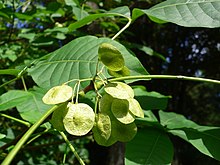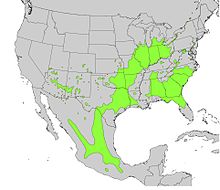Ptelea trifoliata
| Ptelea trifoliata | |
|---|---|
 |
|
| Common hoptree fruit | |
| Scientific classification | |
| Kingdom: | Plantae |
| (unranked): | Angiosperms |
| (unranked): | Eudicots |
| (unranked): | Rosids |
| Order: | Sapindales |
| Family: | Rutaceae |
| Genus: | Ptelea |
| Species: | P. trifoliata |
| Binomial name | |
|
Ptelea trifoliata L. |
|
 |
|
| Natural range | |
| Synonyms | |
|
|
Ptelea trifoliata, the common hoptree,stinking ash or wafer ash, is a species of flowering plant in the Rutaceae family, native to North and Central America. It is a deciduous shrub or tree, growing to 8 m (26 ft) tall by 4 m (13 ft) wide.
Trifoliata refers to the three-parted compound leaf.
Ptelea trifoliata is the second-northernmost New World representative of the Rue (Citrus) family after American prickly-ash (Zanthoxylum americanum).
While Ptelea trifoliata is most often treated as a single species with subspecies and/or varieties in different distribution ranges, some botanists treat the various Hoptrees as a group of four or more closely related species:
Ptelea trifoliata is a small tree, or often a shrub of a few spreading stems, 6–8 m (20–26 ft) tall with a broad crown. The plant has thick fleshy roots, flourishes in rich, rather moist soil. In the Mississippi embayment (Mississippi River Valley) it is found most frequently on rocky slopes as part of the undergrowth. Its juices are acrid and bitter and the bark possesses tonic properties.
The twigs are slender to moderately stout, brown with deep U-shaped leaf scars, and with short, light brown, fuzzy buds. The leaves are alternate, 5–18 cm long, palmately compound with three (rarely five) leaflets, each leaflet 1–10 cm long, sparsely serrated or entire, shiny dark green above, paler below. The western and southwestern forms have smaller leaves (5–11 cm) than the eastern forms (10–18 cm), an adaptation to the drier climates there.
The flowers are small, 1–2 cm across, with 4-5 narrow, greenish white petals, produced in terminal, branched clusters in spring: some find the odor unpleasant but to others trifoliata has a delicious scent. The fruit is a round wafer-like papery samara, 2-2.5 cm across, light brown, maturing in summer. Seed vessel has a thin wing and is held on tree until high winds during early winter.
...
Wikipedia
